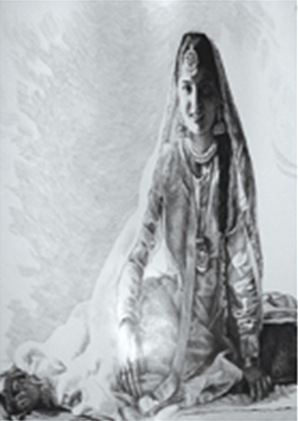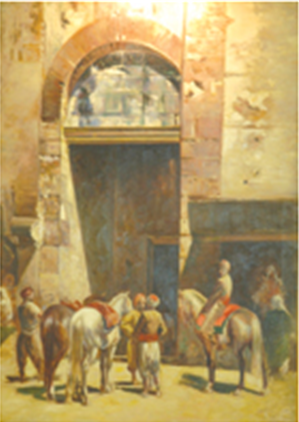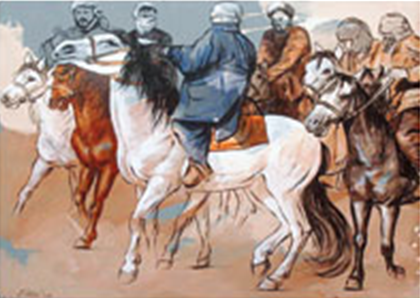Eqbal Mehdi (1946-2008)
This is a collection of articles archived for the excellence of their content. Readers will be able to edit existing articles and post new articles directly |
Eqbal Mehdi (1946-2008)
Eqbal Mehdi (1946-2008)
Eqbal Mehdi impressed many with his selection of subjects and treatment of imagery. Often the beautiful female figures were drawn and painted with a lot of jewellery, covered in drapery that offered a range of surfaces and details of the background, writes Quddus Mirza
At 6.41 pm, on 19th May 2008 I received a text message which read, “Artist Eqbal Mehdi has passed away.” Texts like these make you think about the need, necessity and the nuisance value of the mobile phone, which is employed for transmitting such news, but often in an impersonal, cold — and rather cruel manner.
I didn’t know Eqbal Mehdi personally, nor had I ever met him, but I recall being a young boy eagerly waiting each week for the new issue of Akhbaar-i-Jehan. Not that I was interested in the tales of three women, political commentary, reports of street crime, gossip about the actors and scandals of film actresses. Nor was I keen to read the sports column and children’s jokes or seeing the wedding pictures of newly married couples. The only thing I was anxious to see was the illustration on the inside cover, executed in pen and ink by Eqbal Mehdi, usually accompanied by a piece of poetry.
His line drawings were always detailed, intricate and interesting. It was a new element in the Urdu press, since the magazines were not accustomed to printing illustrations of such kind, and on such a large/important space (spread on the whole page).
So in his way Mehdi was an innovator; he created not only exquisite sketches, but a number of followers too, who filled many digests and magazines imitating his style. His craft, creativity and success were based not only on his command in the skill of drawing, but his close connection with the world of words, as a person who really appreciates the subtleties of poetry and literature.
From his job as an illustrator, Mehdi moved to greater heights and bigger achievements. Till his departure (artists do not die, they depart!), he was known as a painter of naturalistic mode. Usually it is considered that to paint in a realistic manner requires much effort and exercise. In order to excel in this form, one needs to spend years learning the principle of perspective, means of capturing the tone, variety of textures and carefully observing the lines and angles. But with the invention - and availability of the camera, all those notions of hard work have changed. Now a painter can pick a picture, and by closely copying it, is able to produce a convincingly realistic work.
In this situation it does not matter, if one is able to render the world around us in a faithful scheme, because the choice of the subject and the uniqueness of the idea have acquired more importance in order to determine the worth of a photorealistic painter. In that regard, Mehdi impressed many with his selection of subjects and treatment of imagery. Often the beautiful female figures were drawn and painted with a lot of jewellery, covered in drapery that offered a range of surfaces and details of the background. Sensitive depiction of complexion and contours of model, and other objects distinguished Mehdi’s work from his contemporaries.
Now when he is no more with us, one can conveniently criticise his work, without having any thought of rebuke or reprisal. (Actually artists hardly read or notice whatever is written on them during their lifetime either). However, a comment on an artist does not apply only to him, because a number of other practitioners and art enthusiasts can identify with it. In that respect, the label for Mehdi, of being a commercial painter, (coined by a number of our critics) describes his approach towards art. He sought to support himself and his family through his art, and his tremendous skill enhanced the possibility of achieving this ‘private’ goal.
Even if one states, and categorises (a favourite feats among our critics) that Mehdi worked as a commercial artist throughout his life, one has to admit that he was not in the business of creating problems, instigating hurdles and fabricating intrigues in order to spoil his contemporary artists’ good prospects and forthcoming successes. He pursued his preferred practice single-mindedly, and produced a number of works that can be recognised today with his signature style.
After his death, when one looks back at the output of Mehdi, one tends to remember the words of Mian Ijaz-ul-Hassan. Discussing the commercialism in art, increasing gallery business and artists’ responses/responsibility etc, he declared, that if an artist is making ‘commercial’ work, it is perfectly permissible, since he is earning a living by doing hard work, by being a useful and productive citizen of the society, instead of being a lazy person, a corrupt bureaucrat or a professional robber (one wonders if there is a difference between the three!). So one must recognise this fact, as one will recognise other facts about Mehdi with the passage of time, which may take him out of the niche of commercial art, and place him somewhere else — perhaps high! Who knows?
Sensitive depiction of complexion and contours of model, and other objects distinguished Mehdi's work from his contemporaries (Cover photograph courtesy Karachi Marriott Hotel)



